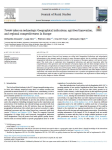Stranieri S., Orsi L., Zilia F., De Noni I., Olper A. (2024). Terroir takes on technology: geographical indications, agri-food innovation, and regional competitiveness in Europe. Journal of rural studies, 01/08/2024, vol. 110, p. 103368.
https://doi.org/10.1016/j.jrurstud.2024.103368
https://doi.org/10.1016/j.jrurstud.2024.103368
| Titre : | Terroir takes on technology: geographical indications, agri-food innovation, and regional competitiveness in Europe (2024) |
| Auteurs : | S. Stranieri ; L. Orsi ; F. Zilia ; I. De Noni ; A. Olper |
| Type de document : | Article |
| Dans : | Journal of rural studies (vol. 110, August 2024) |
| Article en page(s) : | p. 103368 |
| Langues : | Anglais |
| Langues du résumé : | Anglais |
| Catégories : |
Catégories principales 04 - DEVELOPPEMENT LOCAL ET REGIONAL ; 4.3 - Appellations liées au Territoire. Produits du Terroir. QualitéThésaurus IAMM TERROIR ; INDICATION GEOGRAPHIQUE PROTEGEE ; PRODUIT DU TERROIR ; PROVENANCE ; SYSTEME AGROALIMENTAIRE ; EUROPE |
| Résumé : | In the agri-food sector, firms and local systems can utilize both Geographical Indications and technological advancements as key strategic assets for growth in many European regions, but the combined contribution of Geographical Indications and innovation activities to the economy of European regions is still poorly investigated. This study aims to understand how Geographical Indications and agri-food innovation affect the competitiveness of the agriculture and food industry in European regions and how these strategies interact. To achieve this goal, a longitudinal and original dataset has been organized, including data related to Geographical Indications and agri-food patents from 265 European NUTS-2 regions between 1996 and 2014. The data for Geographical Indications and agri-food patents are collected from the eAmbrosia and OECD RegPat databases, respectively. The results show that Geographical Indications have a positive and significant impact on regional competitiveness, while the effect of agri-food innovations is controversial. The implications of these findings in terms of policy design are further discussed. |
| Cote : | En ligne |
| URL / DOI : | https://doi.org/10.1016/j.jrurstud.2024.103368 |







